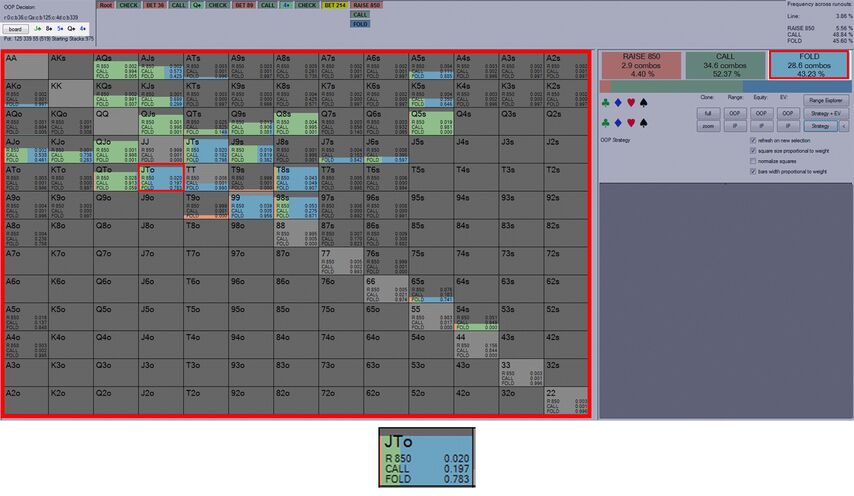(Editor's Note: we continue to bring you expert analysis by sharing this article from December of 2021)
Original article on Upswing Poker
When our opponent bets, we have three options: call, fold, and raise. The situations in which we need to raise are usually obvious – we either have a very strong hand with which we need to collect value, or a bluff when we want to steal the pot. But with calling and folding everything is much more complicated.
When the world's best players decide how to react to a bet, they use two poker concepts: pot odds and minimum defense frequency (MDF).
What is minimum protection frequency?
Minimum Defense Frequency (MDF) shows how often you need to call or raise in response to your opponent's bet so that bluffs against you are not profitable. If you fold more often than MDF, your opponent will be able to exploit you with frequent bluffs.
MDF formula
Pot size / (pot size + bet size)
Multiply by 100 to get the desired percentage
Example
6-max $1/$2 with effective stacks of $200.
Hero was dealt on the button.
MP opened with a $5 raise. Hero calls, and the rest fold.
Flop ($13):
MP bets $8.5. Hero call
Turn ($30):
MP bets $22.5. Hero call
River ($75):
MP bets $37.5. Hero – ?
Your opponent is risking $37.5 to win a $75 pot. Let's apply the MDF formula:
$75 / ($75 + $37.5) = .67
The minimum protection frequency here is 67%. If our opponent is bluffing, he must force us to fold at least 33% of the time for his bluff to be profitable. For Hero's strategy not to be vulnerable, he needs to call more often.
MDF table for the most common bet sizes:

When to use MDF?
Calculate your minimum defense frequency as you work on your game to help you figure out which hands to defend against strong opponents. This will help develop the intuition for moving up the limits, during which the regulars will constantly put pressure on your ranges.
In practice, MDF is not used so often, especially at low limits, where the strategies of most opponents are extremely unbalanced. Therefore, we recommend giving preference to the MDF (over the pot odds) only in cases where you are playing against unknown opponents.
Example
You came to Guatemala for the first time, walked into a casino, and sat down at a $2/$5 table with a $500 stack.
In the first hand, you are in the BB with . A young and possibly experienced CO player opened with a $15 raise. You made a call.
Flop:
You check and your opponent c-bet $20, which you call.
Turn:
The opponent continues to bet – $45, and you call again.
River:
The young player bets the third barrel – $110.
You will have to decide with a marginal hand without having any information about your opponent's play. This is where MDF comes in handy.
Let's analyze this example using PioSolver (Flopzilla will work too). Let's look at the table of the recommended range of BB protection against CO in a live game:

And here is the recommended opening range in the CO:

We enter these ranges and data from the hand into PioSolver and see that the solver recommends a mixed strategy: with JTo you need to fold 78% of the time, call 20%, and raise as a bluff 2%.

Complex mixed strategies of solvers are almost impossible for humans to reproduce, but they can be simplified to be used in practice. For example, we will always fold JT, but compensate for this by always calling with AJ (the solver recommends calling with AJ only 54% of the time).
By following this strategy, you will never make a big mistake. This is the strength of MDF – protection against gross -EV errors.
When not to use MDF?
There are three main situations in which you should definitely not resort to MDF.
1. When defending against a continuation bet on the flop out of position.
You should not use MDF in spots against c-bet after defending the BB – this is confirmed by solver calculations. Defending the flop with MDF will force you to make -EV moves with a significant amount of your range.
The fact is that the enemy here will almost always have an advantage both in range and position. This allows him to play aggressively and bluff a lot, but he paid for this opportunity by taking the risk of raising preflop.
2. When your opponent can't bluff
If your opponent's range consists solely of made hands, it's simply stupid to use MDF. Why defend against bluffs that your opponent doesn't have?
Example
6-max $2/$4, effective stacks $420.
Hero on MP has , and he opens with a $9 raise. Only the button called.
Flop ($22):
Hero checks, BTN bets $11.5. Hero call
Turn ($45):
Hero check. BTN bets $30. Hero call
River ($105.50):
Hero check. BTN bets $50. Hero – ?
The opponent here will not have missed draws – he always has either a pair or something better. There is no point in calling with the MDF, since your opponent's range is too strong and he is unlikely to turn a made hand into a bluff.
In this particular hand, there are enough arguments for folding on the turn – most players will not bluff with enough frequency to justify our calling.
3. Against weak opponents
To maximize profits against weak players who play unbalanced, you need to use an exploitative strategy. And we're not just talking about aggressive bluffs or calls with marginal hands. Don't forget about folds if your opponent rarely bluffs.
Pay attention to your opponent's playing styles and don't play like a robot. Always remember that you are playing against real people, not machines.
How and when to calculate pot odds?
Unlike MDF, the pot odds need to be calculated in almost every hand. They are expressed in ratios (for example, 2 to 1). For convenience, they can be converted into percentages (in this case 33%).
Formula for calculating pot odds
(bet size) / (pot size + bet size + number of chips needed to call)
To find out the pot odds as a percentage, multiply the result by 100
Example
6-max $1/$2, effective stacks $200.
Hero has on the button.
MP opens with a $5 raise. Hero calls
Flop ($13):
MP bets $8.5. Hero calls
Turn ($30):
MP bets $22.5. Hero calls
River ($75):
MP bets $37.5. Hero – ?
There is $75 in the pot, to call you need to invest $37.5. We calculate using the formula:
37.50 / ( 75 + 37.50 + 37.50) = 37.50 / 150 = 0.25
Multiply the result by 100 and get 25%. We need to win so many times for the call to not be negative.
In other words, if we have more than 25% equity against our opponent's betting range, we should always call here.
Pot odds can be applied on all streets, starting preflop. This is a more practical way to determine the optimal calling range than the MDF.
When your opponent bets on the river, pot odds will always help you determine how often you need to come out on top to make calling profitable over the long haul. On early streets this is more difficult to do – the cards that the dealer opens can greatly affect the balance of power.
Pot odds table for the most common bet sizes:





















